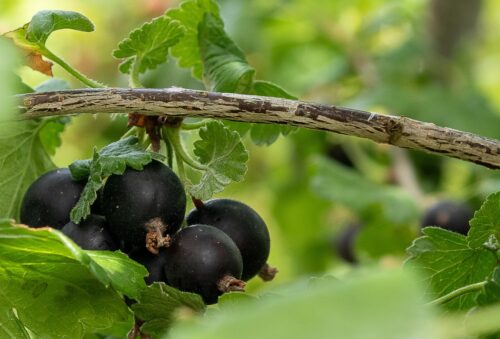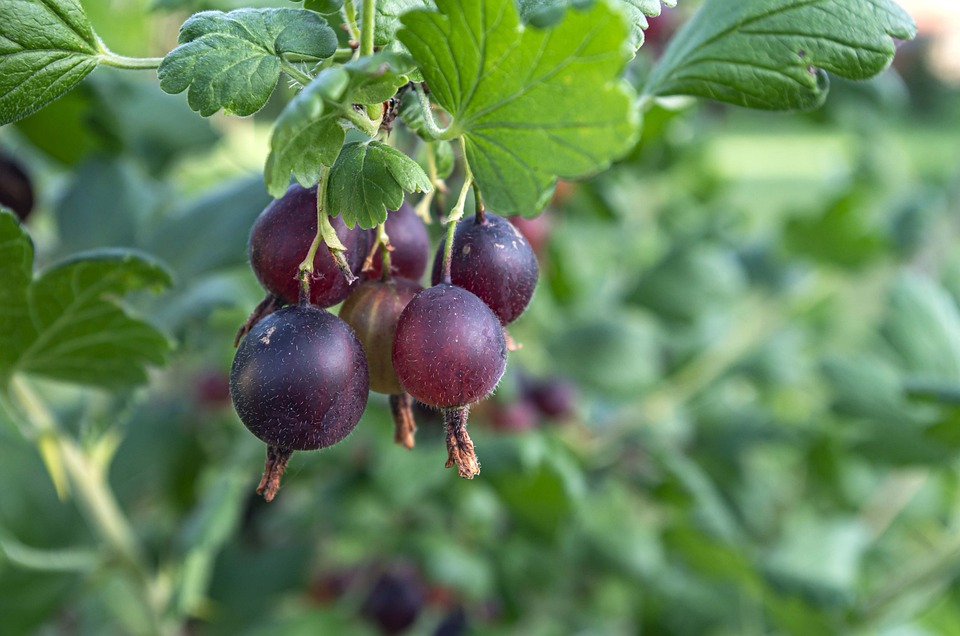Read everything about growing and caring cold-hardy Jostaberry bushes with this guide and enjoy the sweet-tart flavor of the fruits.
Jostaberries (Ribes x nidigrolaria) are popular for their plentiful production of marble-sized, sweet, and tangy fruit during mid-summer. They are a relatively recent addition to berry patches, debuting in 1977. These bushes are a hybrid of tart gooseberries and sweet currants and combine the best qualities of both.
These berries can reach up to 3-6 feet tall and 3-5 feet wide. They produce white blooms over blue-green leaves.
They prefer cold climates and can withstand temperatures as low as -40°F. For optimal fruit yield, it’s recommended to plant at least two different cultivars of this thornless shrub. Jostaberries are available in varieties with red and deep purple, almost black berries. They offer long-lasting fruit that maintains its quality for weeks on the bush, provided it’s shielded from birds.
This fruit offers a sweet and sour taste, sweeter than currant but not sour like gooseberry. Its sweetness makes it enjoyable for fresh consumption and versatile for use in preserves, sauces, pies, and juices.
Fact: The name Josta is made from two German words, blackcurrant (Johannisbeere) and gooseberry (Stachelbeere).
USDA Zones: 3-8
Read: Casaba Melon Care
Planting Jostaberry Bush

When to Plant
Planting jostaberry in mid-spring is optimal as the shrub remains dormant and minimizes the risk of transplant shock. Additionally, this timing allows the plant ample opportunity to establish itself before the start of heat and drought in summer.
Where to Plant
Select a location that gets full sunlight and has good drainage. Amend the area with organic matter in the absence of soil drainage.
Spacing
Plant jostaberry bushes with a 6-feet gap between each to ensure they can grow to their full size without overshadowing neighboring plants. This spacing also reduces the risk of certain plant diseases and pests. When planting, follow standard shrub transplanting guidelines, such as digging a hole twice the width of the root ball.
Types of Jostaberry
Red Josta: The fruit of this cultivar has a red hue.
Josta: It is most frequently available.
Jostaki: Also known as Jostagranda or Jogranda. It offers larger berries than the Jostine variety.
Orus 8: This disease-resistant variety offers delicious fruits.
Justine: It produces large berries compared to the original ones.
Propagating Jostaberry Bushes
Before attempting to propagate a plant, ensure that it is legally permissible. When doubtful, obtain new plants from reputable nurseries. Keep in mind that cultivars, such as the ‘Jostaki’ cultivar of jostaberry, are often patented.
If you’re interested in multiplying your currant, gooseberry, or jostaberry plants, you have two options for propagation, both of which can be done in spring: through cuttings or offshoots. Here’s how to proceed with each method:
From Cuttings
To propagate Jostaberry, take stem cuttings from young canes. Root these cuttings in a moist potting mix and place them in a bright, sunny spot. Provide regular watering and transplant the cutting into the garden once it has established a strong root system. To maintain soil moisture, apply a layer of mulch around the young plant in the garden.
From Offshoots
You’ll need pruners and a shovel for this method. During the beginning of the growing season, select a young, flexible branch. Bend this branch gently down to the ground. Secure the branch in place using any heavy object, like a stone, positioned slightly behind the tip of the branch. Cover the tip of the branch with soil. By the end of the growing season, the tip will develop its own roots. Using pruners, carefully separate the newly rooted “offshoot” from the parent plant.
Transplant the offshoot to the desired location in the garden.
Ideal Growing Conditions for Jostaberry
Location/ Light
For the best yield, grow the Jostaberry bush in full sun. In northern regions, it can tolerate partial shade but may not thrive as vigorously. However, in the southern end of its growing range, particularly in zone 7, some afternoon shade can benefit its growth.
Soil
Use well-drained soil enriched with plenty of organic matter. However, it can withstand sandy soil conditions if adequate watering is provided.
Water
This plant typically requires a moderate amount of water, but the watering frequency should be adjusted according to the soil type. Sandy soil drains water more rapidly and demands more frequent watering to ensure adequate moisture levels.
Temperature and Humidity
One notable strength of the jostaberry is its exceptional hardiness. It is suitable for USDA zone 4 and capable of withstanding temperatures as low as -40 degrees F. Additionally, it adapts well to moderate summer temperatures in median zones. However, it requires a chilling period of 1000 hours to bear fruit, which can pose challenges in regions with high heat and humidity, particularly below zone 7.
Jostaberry Bush Care

Fertilizer
In spring, apply compost as fertilizer annually. Additionally, mulch such as straw can be utilized to suppress weeds, retain soil moisture, and gradually emit nutrients when they decompose.
Pruning
Annual pruning is essential for ideal fruit setting. Jostaberries produce fruit on two- and three-year-old wood. In late winter or early spring, before buds swell, prune all wood older than three years, cutting it back to the base of the shrub. Additionally, thin out younger wood to ensure the bush retains three upright canes of each three-, two-, and one-year-old wood.
Overwintering
Jostaberry is cold-hardy down to zone 4. If you’re in a borderline zone and want to protect your bush from freezing temperatures, spread a 3-inch layer of mulch around the base. Be cautious not to stack mulch against the trunk, as it can attract diseases and pests.
Companion Plants for Jostaberries
You can grow jostaberries along with gooseberries and currants. They flourish in cool climates, reliably overwintering even in regions with harsh winters and yielding abundant crops of flavorful small fruits.
Although they share similar hardiness and growth conditions, each berry offers a unique taste experience. Gooseberries are tart, currants are sweet, and jostaberries hit a balance between sweetness and tartness.
Pests and Diseases
The Jostaberry bush, particularly the ‘Orus 8’ cultivar, shows notable disease resistance. Your primary concern will be safeguarding the berries from wild birds, preventing them from consuming the fruit before harvest. Use netting to cover the shrubs and deter birds and other pests from accessing your harvest.
Additionally, smaller pests such as slugs, snails, and aphids pose potential threats to the foliage on the bush. Fight slugs and snails by implementing traps. For aphids, check their presence on the undersides of leaves by spraying them with organic Neem oil for effective control.
Harvesting Jostaberries
Jostaberry typically requires 2 to 3 years to yield fruit. Harvest ripe berries when they have turned bluish-black and feel firm to the touch. The timing of harvest varies based on climate; in certain regions, you may be able to harvest in July, while in others, it may be later in the summer.
Under favorable conditions and proper care, jostaberry bushes can produce fruit for ten to fifteen years. After harvesting, the berries can be frozen for preservation. Jostaberry is self-pollinating and eliminates the need for multiple plants. However, growing multiple bushes may enhance pollination and lead to larger yields.



